
A grainy, black-and-white image of two ring-like galaxies. On the left is a galaxy with a bright core surrounded by a ring. There is a gap between the core and ring where the black background of space shows through. The galaxy is tilted so that the circular ring appears oval-shaped. On the right is a another circular galaxy, made mostly of a ring of bright dots, which are star clusters. The center of the ring is empty and the black background of space shows through. Together, the galaxies look like the number 10.
Image of Arp 147, also known as IC 298, from Halton Arp's Atlas of Peculiar Galaxies (1966).
In the original catalog it was in the category: Amorphous galaxies - Associated rings. The right galaxy's ring formed when its companion hit its center.
Source
07.12.2025 00:31 — 👍 86 🔁 9 💬 3 📌 1
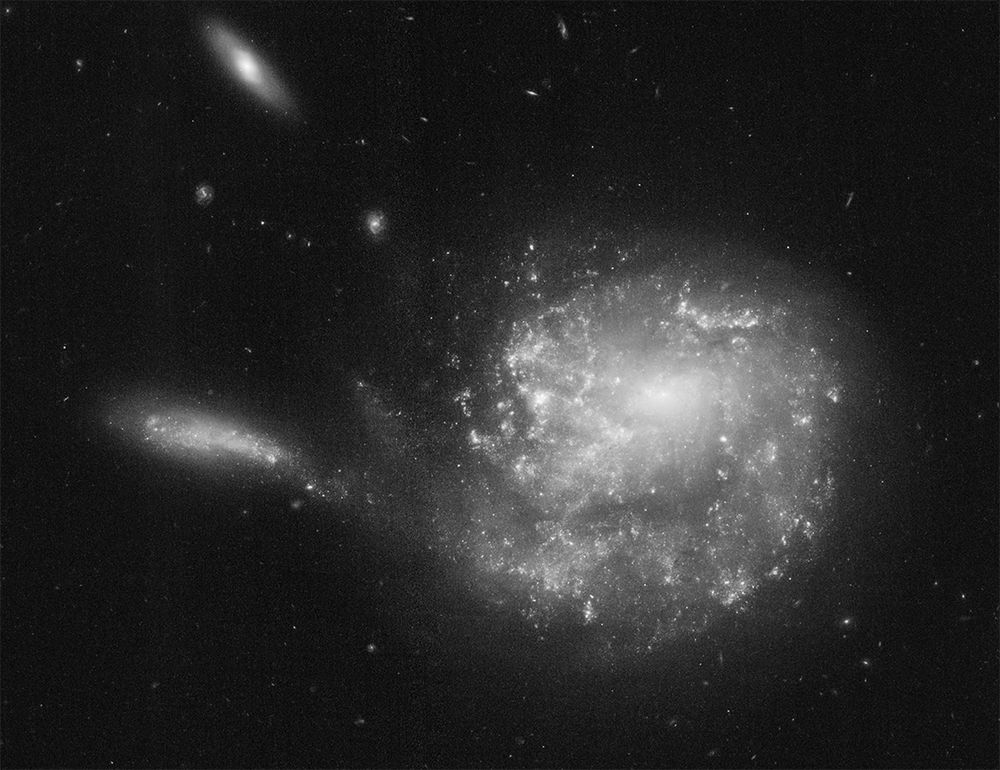
A greyscale image of a spiral galaxy and its smaller companion. The frame is dominated by the large spiral. It has a small core that sits in the middle of a spiral structure. The one spiral arm begins at about 9 o'clock and curves clockwise around the galaxy, completing a full circle. The arm is unusually thick, fanning out with many bright star clusters. To the left of the spiral is a smaller galaxy, seen almost edge-on. It appears as an elongated oval dotted with stars. The long axis of the oval is almost horizontal. Connecting the two galaxies is a faint bridge of gas and stars. A few smaller background galaxies dot the black background of space. The image has some detector noise which have not been removed.
Hubble image of Arp 24, also known as NGC 3445.
NGC 3445 has one fan-like spiral arm that is dotted with star-forming regions. It is connected to its companion galaxy, seen nearly edge-on to the left, by a weak bridge.
Credit: NASA, ESA, STScI, J. Dalcanton, Judy Schmidt
Source
06.12.2025 12:31 — 👍 204 🔁 24 💬 1 📌 0

A grainy, black and white image of two interacting galaxies. A large spiral galaxy with dark dust lanes is in the center of the image. It is tilted slightly, so that its disk forms an oval rather than a circle. The faint ends of spiral arms extend beyond the edge of the disk and appear to connect to its companion galaxy above it. The bright elliptical galaxy is oval shaped with a bright center that gets gradually fainter and more transparent towards its edges. A few white dots, which are stars, are seen on the black background of space.
Image of Arp 94, also known as NGC 3226 and NGC 3227, from Halton Arp's Atlas of Peculiar Galaxies (1966).
In the original catalog it was in the category: Spiral galaxies - Elliptical companions. Spiral NGC 3227 interacts with elliptical NGC 3226.
Source
06.12.2025 00:31 — 👍 355 🔁 31 💬 1 📌 1
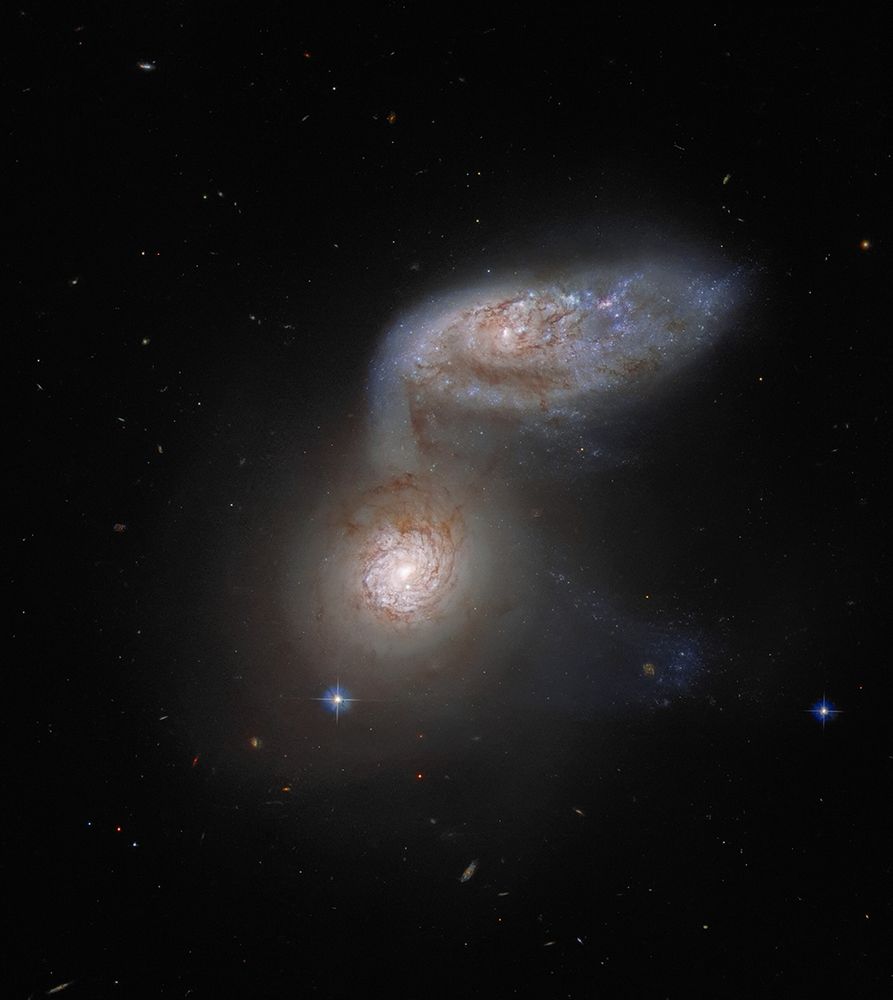
A pair of interacting spiral galaxies. The galaxy in the center appears face-on with a bright yellow center, surrounded by swirls of brown dust filaments. The outer areas of the galaxy are filled with a haze of pale yellow stars. Above and slightly to the right is its companion galaxy. The disk of this galaxy is seen at an angle, tilted so that it appears to be an oval rather than a circle. Dark brown dust filaments somewhat obscure the spiral structures in its disk, which is filled with blue star clusters and pink star forming regions. At the left edge of this galaxy, the end of a spiral arm or a tidal tail appears to extend downwards, connecting to the top of its companion. At the right edge of the central galaxy is what appears to be a faint tidal tail, dotted with blue star clusters, perhaps a continuation of the tail from the companion galaxy. The black background of space is dotted with foreground stars and tiny background galaxies.
Hubble image of Arp 91, also known as NGC 5953 and NGC 5954.
NGC 5953 (center) and NGC 5954 (top) show clear signs of interaction. A spiral arm or tidal tail from NGC 5954 extends to the side and connects to its companion.
Credit: ESA, NASA, J. Dalcanton, J. Schmidt
Source
05.12.2025 12:31 — 👍 208 🔁 23 💬 2 📌 1
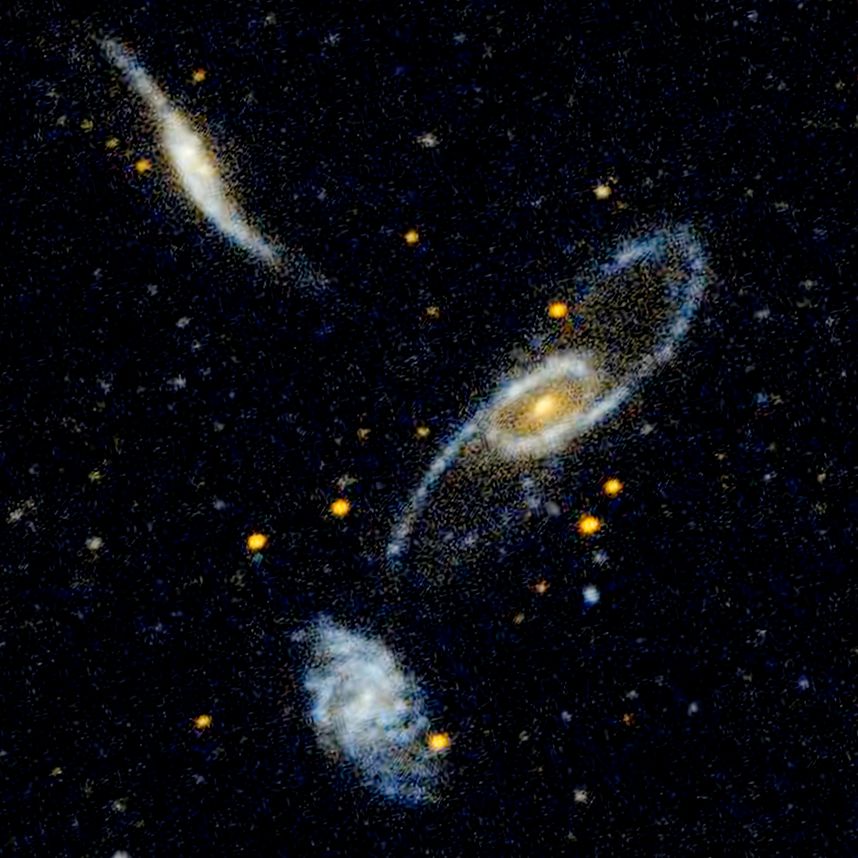
The frame is dominated by three spiral galaxies in shades of yellow and blue. The largest is at the center of the frame. The disk of the galaxy is tilted, so that it appears oval-shaped, with the long axis running diagonally from upper right to lower left. It has a bright yellow center, surrounded by a ring structure. Emerging from the ring are two spiral arms, defined by blue star clusters. The arms for a tiled, backward S-shape. At the bottom left is a smaller face-on spiral galaxy. Unlike the other two galaxies in the group, this galaxy does not appear distorted. It has a small core, surrounded by loose spiral arms that are filled with blue star clusters. At upper left is a distorted spiral galaxy seen nearly edge-on. Its disk is warped, forming a thin, nearly vertical, backward S-shape.
GALEX image of Arp 286, also known as NGC 5560, NGC 5566, and NGC 5569.
Ultraviolet light shows the youngest, hottest stars in this interacting galaxy triplett. NGC 5566 is at center, NGC 5569 at bottom left, and NGC 5560 at top left.
Credit: NASA, JPL-Caltech
Source
05.12.2025 00:31 — 👍 2 🔁 0 💬 0 📌 0

A grainy, black and white image of a face-on spiral galaxy. The galaxy appears somewhat small and slightly left of center in the frame. Beginning from the right edge of the central core, a single arm spirals counterclockwise from the 3 o'clock to the 12 o'clock positions. A second, even smaller spiral galaxy appears to the bottom left. Many white dots, which are stars or galaxies, are seen on the black background.
Image of Arp 23, also known as NGC 4618, from Halton Arp's Atlas of Peculiar Galaxies (1966).
In the original catalog it was in the category: Spiral galaxies - One-armed. Its unusual shape may come from interactions with its companion.
Source
04.12.2025 12:31 — 👍 128 🔁 15 💬 1 📌 0

A galaxy merger forms an amorphous shape, with a band of dark dust silhouetted on top of blue white stars. In the center of the frame is a haze of stars that forms a squished X-shape. The stars are densest in the center, becoming a faint, fuzzy halo near the edges. A thick, dark band of brown dust crosses the center of the frame, curving slightly downwards. A few tiny background galaxies and foreground stars are seen near the edges of the frame.
Hubble image of Arp 157, also known as NGC 520.
Two disk galaxies began colliding about 300 million years ago, forming the mess that is NGC 520. The disks of the two original galaxies have merged together, but the nuclei have not yet coalesced.
Credit: NASA, ESA, STScI
Source
04.12.2025 00:31 — 👍 190 🔁 23 💬 2 📌 2
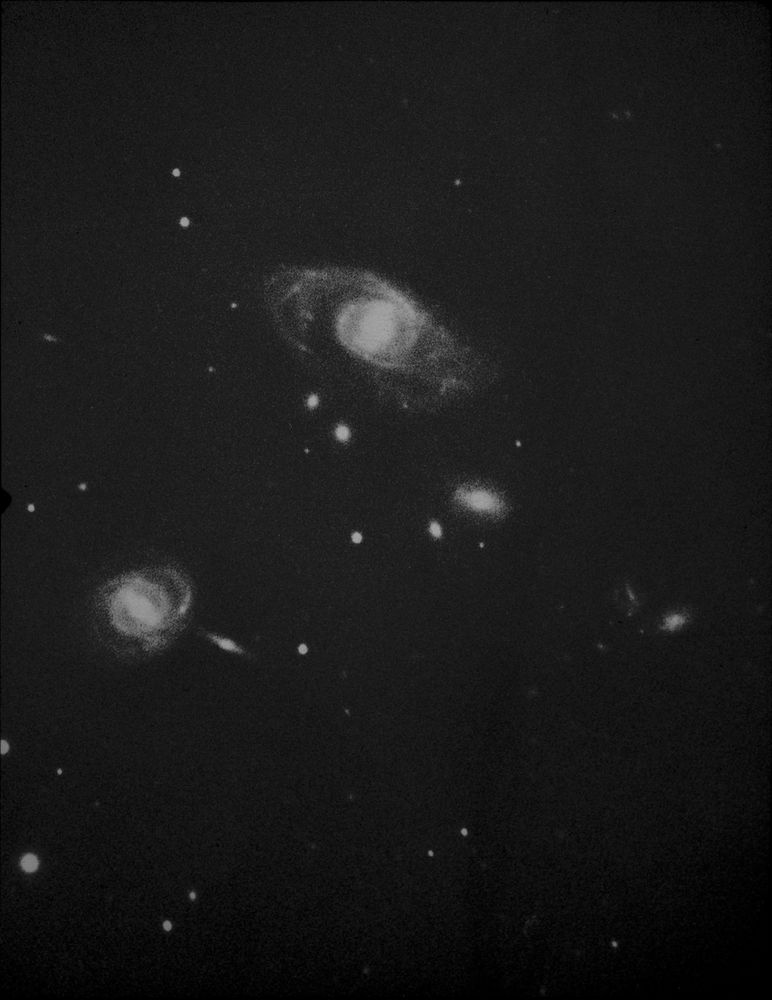
A grainy, black and white image of a group of several spiral galaxies. The upper galaxy, UGC 717, has a small core, and a bar surrounded by a ring structure. On the outside of the ring are several spiral arms, including one arm that splits in two as it curves around the left side of the galaxy. The spiral in the bottom left, UGC 719, has a small core, and a bar surrounded by a ring structure. On the outside of the ring are several somewhat ill-defined spiral arms. In the background are several other smaller galaxies. Many white dots, which are stars, are seen on the black background.
Image of Arp 11, also known as UGC 717, from Halton Arp's Atlas of Peculiar Galaxies (1966).
In the original catalog it was in the category: Spiral galaxies - Split arms. UGC 717 is the large spiral galaxy at center.
Source
03.12.2025 12:31 — 👍 135 🔁 20 💬 1 📌 0
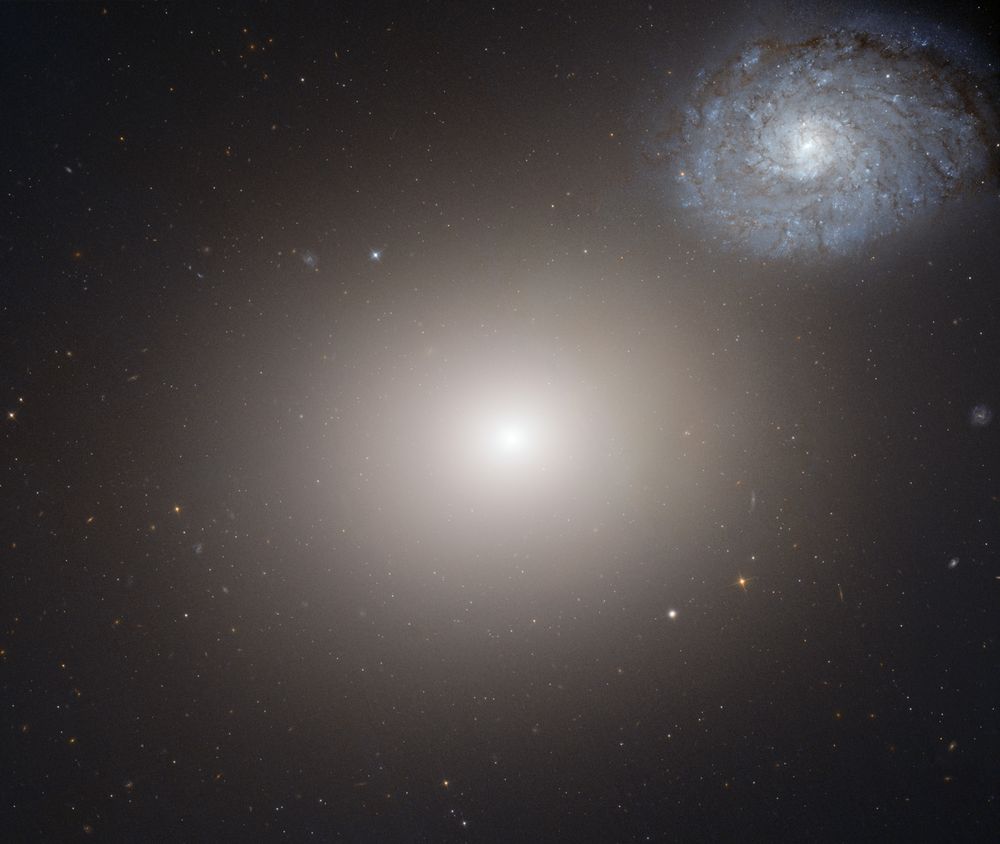
A large elliptical galaxy fills most of the frame. It has a bright yellow-white center that is surrounded by a halo made of a haze of stars. It is more opaque at its center and gradually becomes more translucent near its edge. In its lower right is a yellow-white dot. In the upper right corner is a smaller face-on spiral galaxy. Its somewhat poorly defined spiral arms curve around its bright center. The arms are dotted with blue stars and star clusters and are crossed by a series of filamentary dust lanes. The black background of space is dotted with foreground stars and tiny background galaxies.
Hubble image of Arp 116, also known as M60 and NGC 4647.
M60 is a giant elliptical galaxy. The smaller spiral NGC 4647 is about the size of our galaxy, the Milky Way. While it is not obvious, the two galaxies are just beginning to interact.
Credit: NASA, ESA, STScI
Source
03.12.2025 00:31 — 👍 6 🔁 1 💬 0 📌 0

A panel showing three views of a pair of merging galaxies. On the right the pair is seen in shades of blue. The galaxy on the bottom right has a single, large spiral arm curving out from the core counterclockwise, from the 9 o'clock to the 3 o'clock positions. The upper left galaxy has a bright blue-white core but only a bit of very faint material. A broad curtain of stars and gas connects the two galaxies’ cores. A few blue dots, which are stars and galaxies are scattered around the black background. In the middle panel, the same galaxies are shown in shades of red. The structures in the bottom right spiral galaxy are still prominent, but only the core of the upper left galaxy is still visible. In the right panel the two views are combined. The bottom right galaxy is a combination of red and blue, with the blue structures extending slightly wider than the red ones. The upper left galaxy and the background stars and galaxies are mostly blue. Text: Interacting galaxy pair Arp 107, NASA/JPL-Caltech/B. J. Smith (East Tennessee State University), Spitzer Space Telescope•IRAC, sig05-006
Spitzer image of Arp 107, also known as UGC 5984.
The short wavelength left image highlights older stars, while the longer wavelength middle image highlights younger stars. The multi-band picture shows the two stellar age groups.
Credit: NASA, JPL-Caltech, B. J. Smith
Source
02.12.2025 12:31 — 👍 51 🔁 2 💬 1 📌 0
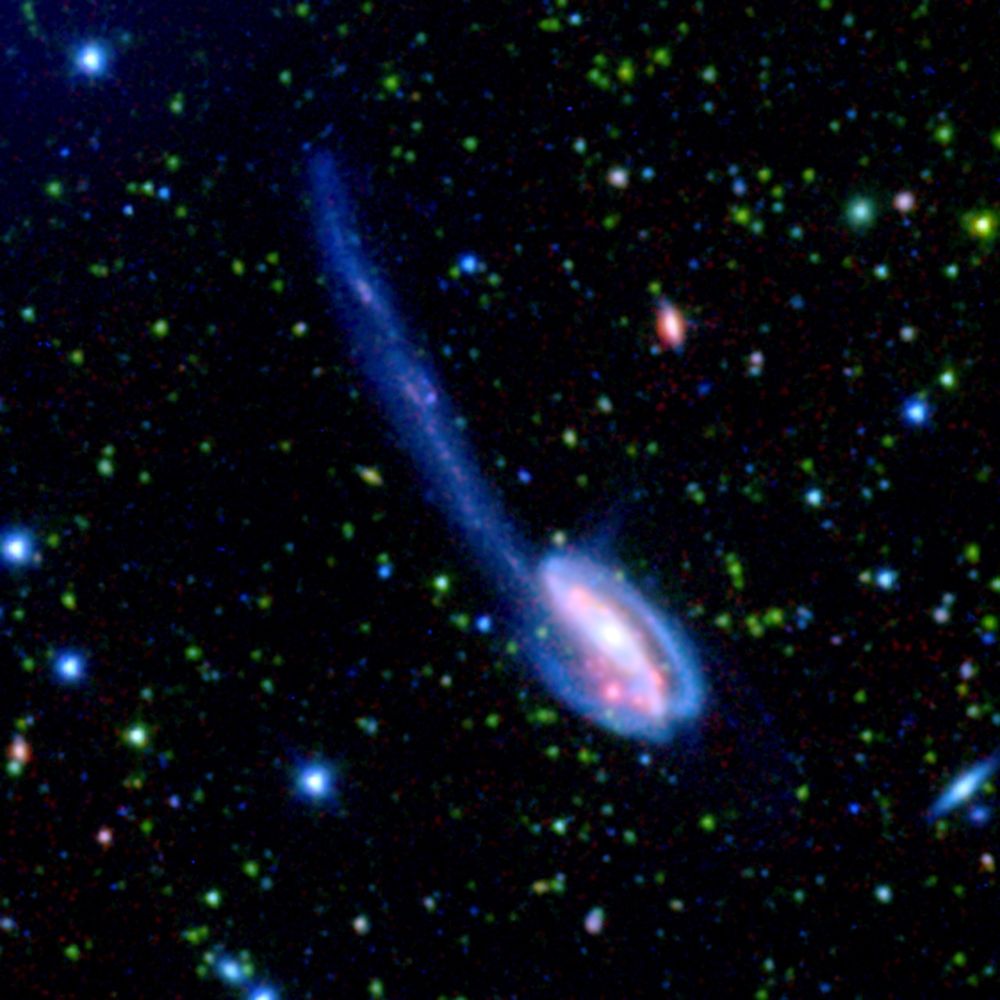
In the bottom right corner is a spiral galaxy with a bright pink-white central core encircled by two wispy arms that form a loose spiral around the core. The view is somewhat oblique, giving the galaxy an oval appearance. A long, thin, diffuse stream of blue stars and gas extends from the upper left side of the galaxy up to the upper left corner of the frame. Scattered across the background are hundreds of tiny smudges of light, which are stars and background galaxies. They vary slightly in size, shape, and color. Most appear in the shape of small dots, ovals, or lines. They come in different shades of red, blue and green.
Spitzer image of Arp 188, also known as the Tadpole Galaxy.
It is a result of a recent galactic interaction. A small intruder galaxy created a 280,000 light-year-long tail of stars and gas.
Credit: NASA/JPL-Caltech/C. Lonsdale (IPAC/Caltech), SWIRE Team
Source
02.12.2025 00:31 — 👍 68 🔁 14 💬 1 📌 1
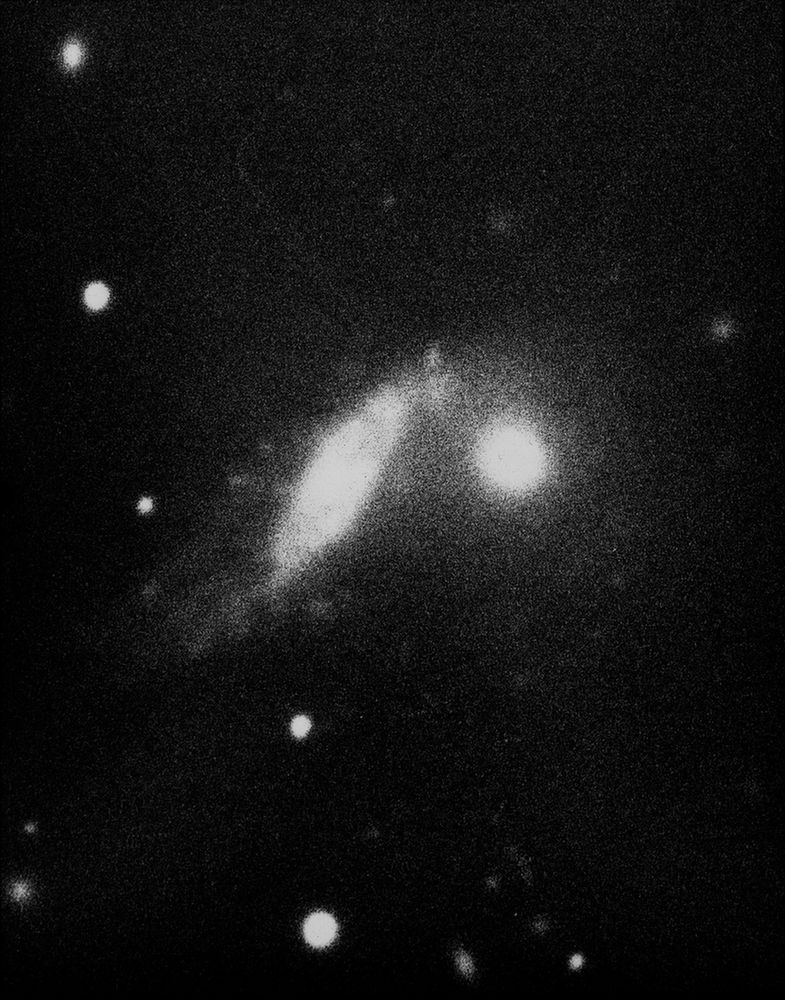
A grainy, black-and-white image of a pair of merging galaxies. One is seen face-on and is circular in shape. There is no detail in the center. The other galaxy is seen as a disk tilted away from the viewer and it is partially warped. It has a rough American football shape. Various small galaxies and stars cover the scene, seen as fuzzy white points. The background of space is black.
Image of Arp 122, also known as NGC 6040 and LEDA 59642, from Halton Arp's Atlas of Peculiar Galaxies (1966).
In the original catalog it was in the category: Elliptical galaxies - Close to and perturbing spiral galaxies.
Source
01.12.2025 12:32 — 👍 36 🔁 2 💬 0 📌 0

Five galaxies appear close to each other in the sky. At upper left, a spiral galaxy is tilted, appearing wider than it is tall. It has a glowing yellow-white center and brown dust trails that spiral clockwise around it. Above the center is a large elliptical galaxy. Its round, glowing yellow-white center is surrounded by a fuzzy halo that fades away from the core. Toward the bottom right are three galaxies that appear to touch. The largest is in the center: a nearly vertical, edge-on spiral galaxy. Its glowing yellow-white core is mostly obscured by reddish-brown dust trails dotted with blue stars. To its bottom left is a smaller, tilted spiral galaxy with a glowing white center. Brown dust trails are dotted with blue stars. One spiral arm appears to touch the vertical galaxy to its right. At the spiral’s bottom right is a lenticular galaxy with a glowing central core in the middle of a hazy white disk, appearing almost face-on. It seems to touch the large spiral galaxy above it.
Hubble image of Arp 321, also known as Hickson 40.
This group of galaxies include three spiral galaxies, an elliptical galaxy, and a lenticular (lens-like) galaxy.
Credit: NASA, ESA, STScI, Judy Schmidt
Source
01.12.2025 00:31 — 👍 100 🔁 18 💬 2 📌 2

A pair of interacting galaxies. The galaxy on the left is likely an edge-on disk galaxy, appearing as a slightly warped, fuzzy, white horizontal line with dust filaments at its center. The galaxy on the right is a ring galaxy, appearing as a blue circular ring, dotted with blue star clusters, that also has its center partially filled in with blue star clusters. The two galaxies overlap so that the right end of the edge-on galaxy intersects with the ring galaxy's center. It looks a bit like a big blue hand holding the Enterprise in a classic episode of Star Trek.
Hubble image of Arp 148, also known as Mayall's Object.
The nickname comes from astronomer Nicholas Mayall, who first imaged the object in 1940 and noted it looked like a question mark.
Credit: NASA, ESA, STScI, A. Evans, K. Noll, and J. Westphal
Source
30.11.2025 12:31 — 👍 98 🔁 18 💬 4 📌 2

A pair of interacting spiral galaxies. The galaxy on the left is seen nearly face-on. It has a bright central core surrounded by a disk seen in shades of pastel yellow and brown. The disk is dotted with star clusters and crossed by light brown dust lanes. At the edges of the disk are two short, faint, wide spiral arms. The galaxy on the right is seen edge-on. It's disk forms a yellow line, crossed by dark brown dust lanes. In the center of the galaxy, the circular bulge emerges on either side of the disk. The black background of space is dotted with stars and small background galaxies.
Hubble image of Arp 293, also known as NGC 6285 and NGC 6286.
NGC 6285 (left) and NGC 6286 (right) have roughly equal masses. Their mutual gravitational attraction pulls streams of gas, stars, and dust from the galaxies as they interact.
Credit: ESA,NASA, K. Larson et al.
Source
30.11.2025 00:31 — 👍 56 🔁 7 💬 1 📌 0
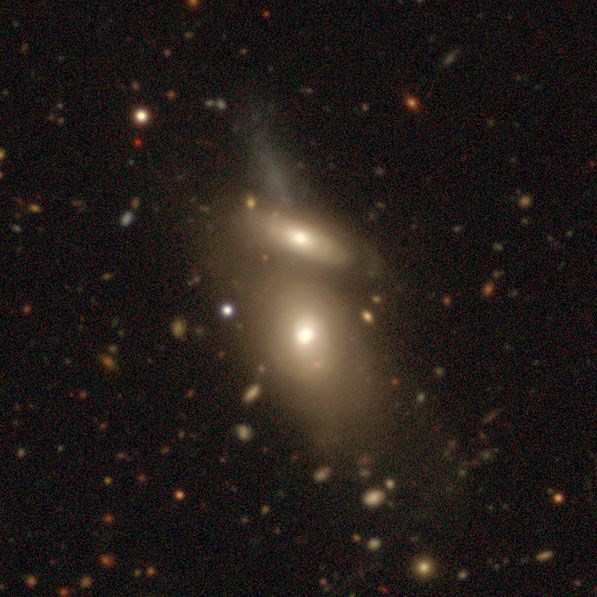
Two galaxies in shades of muted yellow and cream. The bottom galaxy is roughly circular and the upper galaxy appears oval-shaped. Both have bright cores and become more translucent towards their edges. A slightly bluish fuzzy line appears above the top galaxy. The background is dotted with yellow and orange stars and tiny background galaxies.
Legacy Surveys image of Arp 201, also known as UGC 224.
Arp 201 is an interacting galaxy pair.
Credit: Legacy Surveys, D. Lang, NERSC, Meli thev, Wikimedia Commons
Source
29.11.2025 12:31 — 👍 32 🔁 2 💬 0 📌 0

A somewhat grainy image of a pair of interacting spiral galaxies. The two galaxies appear to be almost touching, making a V shape. The galaxy on the left is seen edge-on. A bright central core bulges out slightly and is crossed by a dark dust lane. The disk of the galaxy is seen as a line, dotted with blue star clusters. A hazy bit of material rises almost perpendicular to the disk at the upper end, the top of the V, and points towards its companion galaxy. The right galaxy is seen face-on. It has a bright yellow core and horizontal bar, which is crossed by dark dust lanes. Two spiral arms emerge from the ends of the bar, creating a sideways S shape. They are dotted by teal star clusters. Additional blue stars and star clusters fill in the disk and a swirl of hazy material connects back to its companion galaxy. Other distant galaxies and stars fill the black background of space.
Legacy Surveys DR9 image of Arp 301, also known as UGC 6204 and UGC 6207.
In this interacting pair of spiral galaxies, UGC 6207 is the edge-on galaxy to the left and UGC 6204 is the face-on barred spiral to the right.
Credit: Legacy Surveys, D. Lang, NERSC
Source
29.11.2025 00:31 — 👍 32 🔁 6 💬 0 📌 0
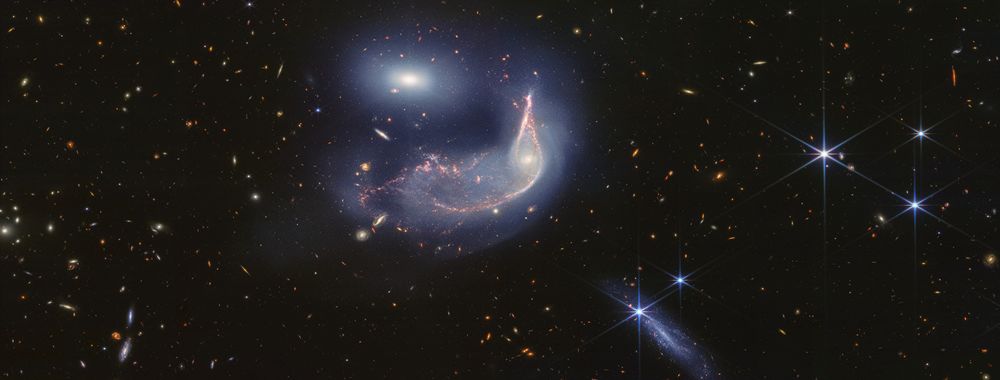
Arp 142, two interacting galaxies, take up less than a third of the frame. At the top is NGC 2937, nicknamed the Egg. Its center is brighter and whiter. There are six diffraction spikes atop its gauzy blue layers. At the center is NGC 2936, nicknamed the Penguin. In this view it is resting on its back, facing up. Its beak-like region points toward and above the Egg. Where the eye would be is a small, opaque yellow spiral. The Penguin’s distorted arms and thin red dust lanes from the bird’s beak, back, and tail. The tail is wide and layered, like a beta fish’s tail. A semi-transparent blue hue traces the Penguin and extends from the galaxy, creating an upside-down U over top of both galaxies. At bottom center-right is another galaxy seen from the side, pointing at an angle. It is largely light blue. Its length appears approximately as long as the Egg’s height. There are several foreground stars with large, bright blue diffraction spikes. The wide black background is filled with tiny, extremely distant galaxies.
JWST NIRCam image of Arp 142, also known as NGC 2936 and NGC 2937, or the Penguin and the Egg.
In this wide view, we see the Penguin and the Egg galaxies, a foreground edge-on spiral, and a large number of distant galaxies.
Credit: NASA, ESA, CSA, STScI
Source
28.11.2025 12:32 — 👍 53 🔁 6 💬 1 📌 0

A grainy, black and white image of a face-on spiral galaxy. It has two well-defined spiral arms that spiral counter-clockwise from its center. Several white dots, which are stars, are seen on the black background.
Image of Arp 1, also known as NGC 2857, from Halton Arp's Atlas of Peculiar Galaxies (1966).
In the original catalog it was in the category: Spiral galaxies - Low surface brightness. It is a spiral galaxy in the constellation Ursa Major.
Source
28.11.2025 00:31 — 👍 91 🔁 12 💬 0 📌 0
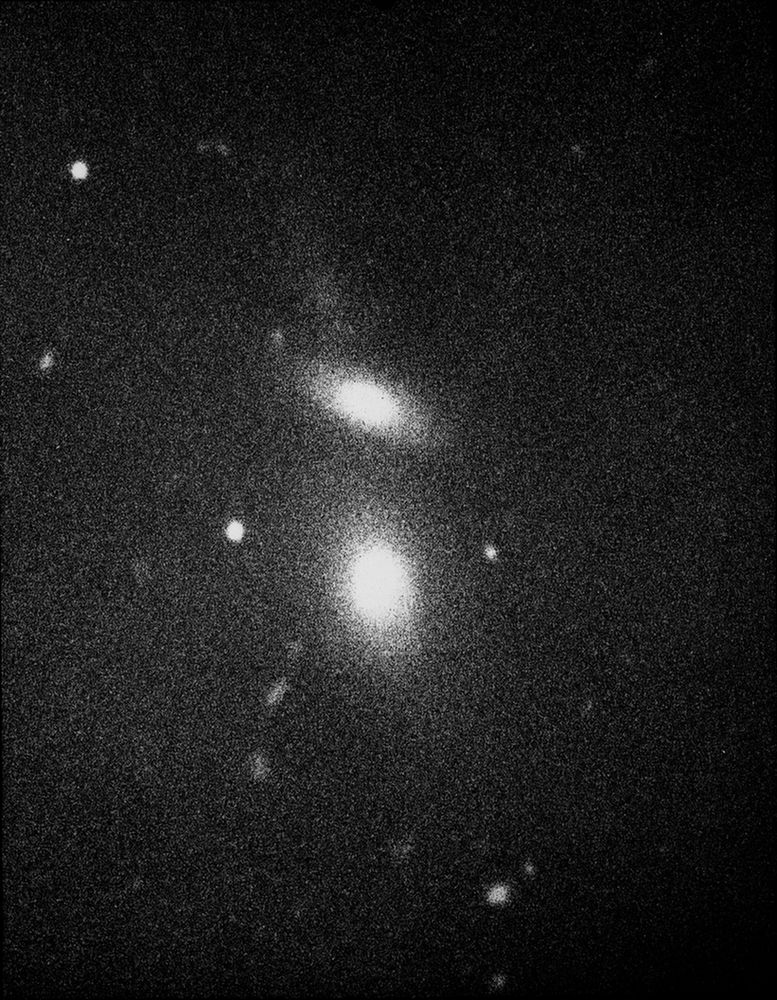
A grainy, black and white image of two galaxies. The bottom galaxy is roughly circular and the upper galaxy appears oval-shaped. Both have bright cores and become more translucent towards their edges. A fuzzy line appears above the top galaxy. A few white dots, which are stars, are seen on the black background.
Image of Arp 201, also known as UGC 224, from Halton Arp's Atlas of Peculiar Galaxies (1966).
In the original catalog it was in the category: Amorphous galaxies - Material ejected from nuclei. Arp 201 is an interacting galaxy pair.
Source
27.11.2025 12:31 — 👍 2 🔁 0 💬 0 📌 0
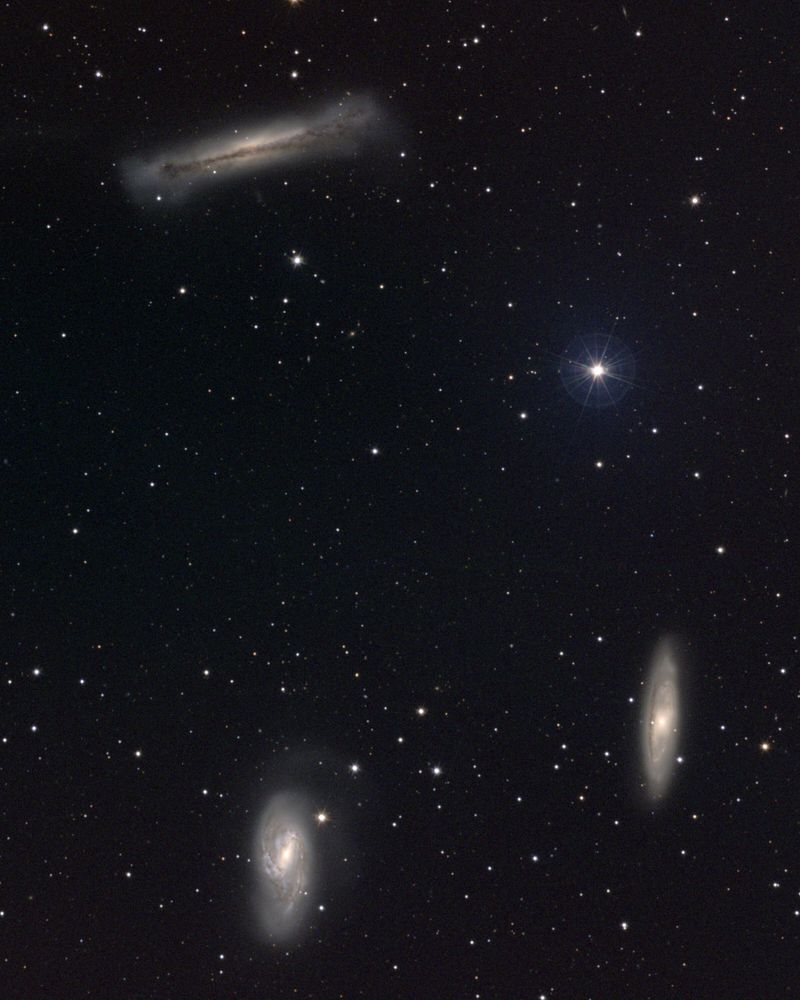
Three widely separated galaxies on the black background of space. The galaxy at the upper left is an edge-on spiral, seen as a wide, bright line with a dark dust lane going through the middle. The galaxy at lower left is a face-on barred spiral galaxy, with a bright central bar and two spiral arms, which form an S-shape. The galaxy at lower right is a nearly face-on spiral, with a bright nucleus and curving dust lanes. Several foreground stars dot the image.
Burrell Schmidt telescope image of Arp 16, also known as M66.
M66 is part of the Leo Triplet, a small galaxy group. Edge-on spiral NGC 3628 is at upper left. The nearly face-on spirals M66 and M65 are at lower left and lower right.
Credit: REU program, NOIRLab, NSF, AURA
Source
27.11.2025 00:31 — 👍 55 🔁 6 💬 1 📌 0

A grainy, black and white image of a pair of spiral galaxies, one seen nearly edge-on and one seen face-on. The face-on spiral at bottom has a bright central core and two well-defined spiral arms that loop counterclockwise around the galaxy. The outer arms are dotted with star clusters. One spiral arm begins at about 6 o'clock, curls around to the top of the galaxy at 12 o'clock and then ends at the bottom of the galaxy around 6 o'clock. The second arm begins at around 12 o'clock and curls around, ending at around 3 o'clock. The nearly edge-on galaxy overlaps at the top of the face-on galaxy, appearing like a continuation of the face-on galaxy's second spiral arm. It's disk is tilted, so it appears as a long, thin oval rather than a circle. The galaxy also has a bright central core and an outer edge dotted with star clusters. A few white dots, which are stars, are seen on the black background.
Image of Arp 30, also known as NGC 6365, from Halton Arp's Atlas of Peculiar Galaxies (1966).
In the original catalog it was in the category: Spiral galaxies - One heavy arm. This is actually a pair of galaxies, one face-on and one edge-on.
Source
26.11.2025 12:31 — 👍 6 🔁 1 💬 0 📌 0

An interacting pair of spiral galaxies. Both are slightly skewed, so that their disks appear to be ovals rather than circles. The galaxy on the left has its long axis oriented horizontally and the right galaxy has its long axis oriented vertically. Both galaxies have bright, cream-colored centers that transition into two wide, S-shaped spiral arms. The spiral arms are dotted with blue star clusters and crossed by brown dust lanes. The galaxy on the left appears to have a squatter S-shape and thinner dust lanes in its arms, the galaxy on the right has a longer S-shape and thicker dust lanes in its arms. A faint bridge of stars and gas connects the top arm of the left galaxy to the bottom arm of the right galaxy. The black background of space is dotted with a few foreground stars and tiny background galaxies.
Hubble image of Arp 240, also known as NGC 5257 and NGC 5258.
NGC 5257 (left) and NGC 5258 (right), two spiral galaxies of similar mass and size, are in the early stages of a merger.
Credit: NASA, ESA, STScI
Source
26.11.2025 00:31 — 👍 157 🔁 33 💬 5 📌 1

A slightly inclined spiral galaxy. In the center is a bright yellow core. The galaxy's stars and gas form a loose two-armed barred spiral, forming an S-shape. Dark, filamentary dust lanes and pink regions of star formation are seen throughout the spiral arms. At the bottom edge of the galaxy, in line with the bar, is what looks like a third spiral arm.
Kitt Peak National Observatory image of Arp 18, also known as NGC 4088.
NGC 4088 is an asymmetric spiral galaxy, located about 40 million light years away.
Credit: KPNO, NOIRLab, NSF, AURA, Bonnie Fisher, Mike Shade, Adam Block
Source
25.11.2025 12:31 — 👍 12 🔁 0 💬 0 📌 0

A grainy, black and white image of a pair of galaxies. The larger galaxy to the lower left is seen nearly face-on. It has a small core that transitions into clumpy spiral arms that are dotted with bright star clusters. More star clusters appear on the top of the galaxy, the side that faces its companion. The smaller galaxy to the upper right has a bright center that is surrounded by star clusters that only very roughly form spiral arms. Other distant galaxies and stars fill the black background of space.
Image of Arp 300, also known as UGC 05028 and UGC 05029, from Halton Arp's Atlas of Peculiar Galaxies (1966).
In the original catalog it was in the category: Double and multiple galaxies - Unclassified objects.
Source
25.11.2025 00:31 — 👍 28 🔁 5 💬 0 📌 0
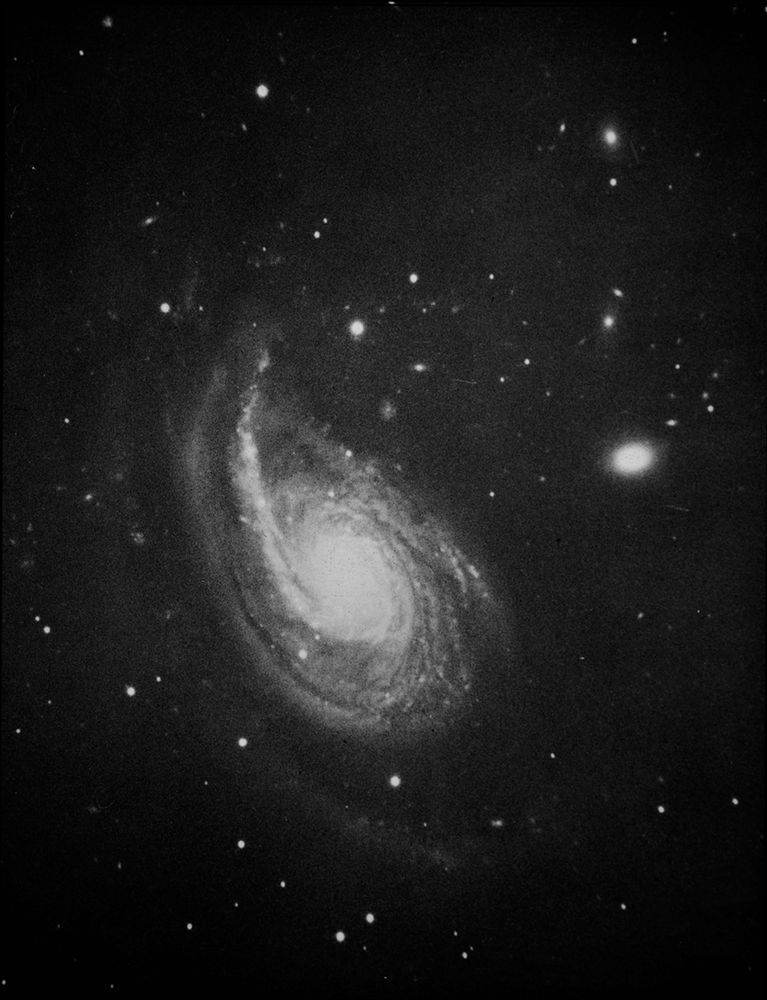
A grainy, black and white image of a nearly face-on spiral galaxy. Appearing somewhat like an aerial view of a hurricane, the galaxy's spiral arms swirl around a bright center. The curling arms are defined by dark dust lanes. While the arms in the right half of the galaxy are somewhat poorly defined, in the left of the galaxy, one overdeveloped spiral arm curves clockwise from about 6 o'clock to about 11 o'clock. Since this arm flattens out near its end, in contrast to the rounder right half, the overall shape of the galaxy resembles a paisley. To its right, near the center, is its small companion galaxy, seen as a fuzzy oval. The black background of space is filled with many white dots which are stars.
Image of Arp 78, also known as NGC 772 and NGC 770, from Halton Arp's Atlas of Peculiar Galaxies (1966).
In the original catalog it was in the category: Spiral galaxies - Small, high surface brightness companions.
Source
24.11.2025 12:31 — 👍 46 🔁 6 💬 1 📌 1

Black and white image of a face-on spiral galaxy. I has a bright core and several spiral arms, dotted with stars and star clusters, that spiral clockwise around the core. They are crossed by dark dust lanes. The arms are well-defined but asymmetric. One arm curls from about 6 o'clock to 9 o'clock and is mostly separated from the body of the galaxy. Another arm follows more closely to the core, from about 6 o'clock to 12 o'clock. Another other arms cover the area from 12 o'clock to 6 o'clock.
Kitt Peak image of Arp 26, also known as M101 or the Pinwheel Galaxy.
This image was taken in 1975 image with the 4-meter Mayall telescope.
Credit: NOIRLab, NSF, AURA
Source
24.11.2025 00:31 — 👍 26 🔁 6 💬 0 📌 0
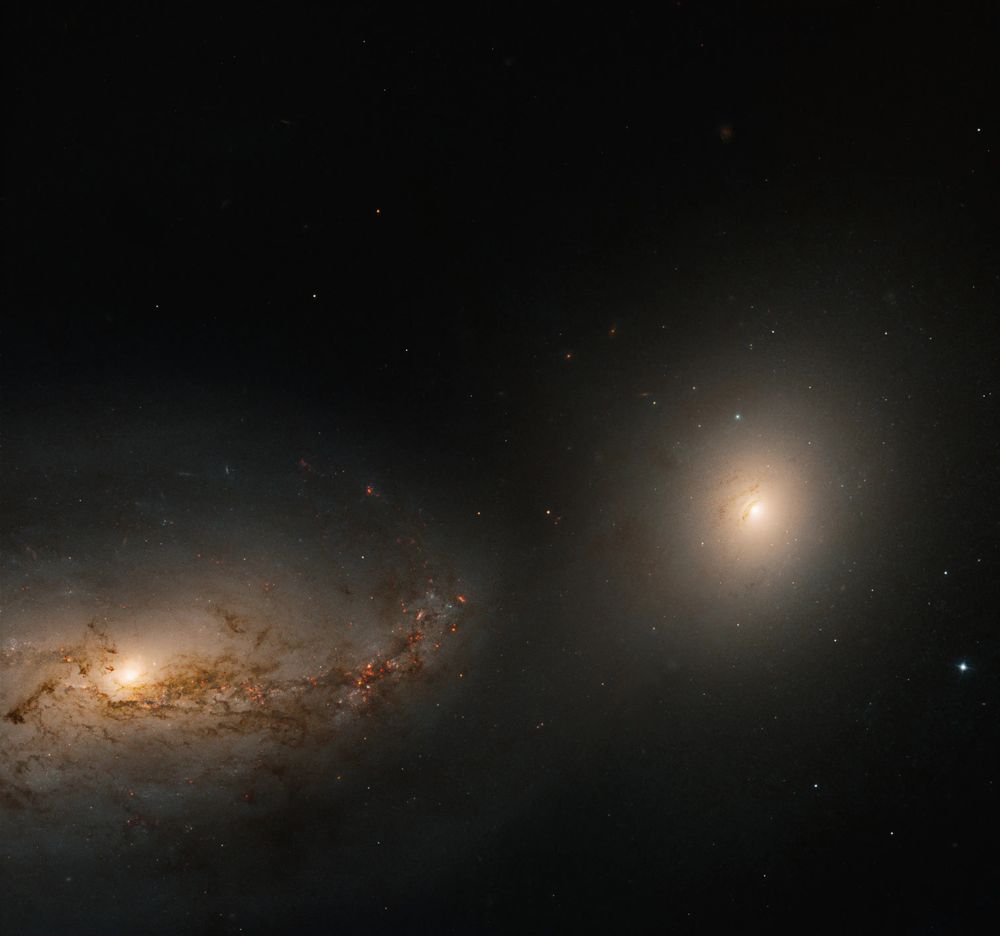
Two interacting galaxies. A large spiral galaxy with reddish brown dust lanes dotted with red star forming regions is in the left of the image. The galaxy's left half is cut off by the edge of the frame. The galaxy is tilted slightly, so that its disk forms an oval rather than a circle. A very faint bridge of material extends beyond the edge of the disk and appears to connect to its companion galaxy. In the center right is a bright elliptical galaxy. It is oval shaped with a bright center that gets gradually fainter and more transparent towards its edges. In the center of the galaxy are very faint brown dust lanes. The black background of space is dotted with foreground stars and tiny background galaxies.
Hubble image of Arp 94, also known as NGC 3226 and NGC 3227.
The large spiral galaxy, NGC 3227 is interacting with its elliptical galaxy companion, NGC 3226. Faint tidal streams of gas and dust link the pair.
Credit: NASA, ESA, and H. Ford, G. Kober
Source
23.11.2025 12:31 — 👍 64 🔁 10 💬 0 📌 0

Two spiral galaxies take up most of the frame. At left is a more oblique galaxy that has a bright yellow core and fainter spiral arms dotted with pink star forming regions. At right is a nearly face-on spiral galaxy. It has a smaller yellow core and two well-defined spiral arms dotted with blue star clusters and pink star forming regions. The upper arm forks in two near its end. Near the center of the galaxy, the arms are crossed with brown dust lanes. The spiral arms of the two galaxies appear to form a faint bridge connecting the pair. The black background of space is dotted with stars and small background galaxies.
Gran Telescopio Canarias image of Arp 271, also known as NGC 5426 and NGC 5427.
The mutual gravitational interaction of this pair of spiral galaxies distorts their shapes and creates a bridge of gas, dust and young stars that connect the galaxies.
Credit: GTC, IAC
Source
23.11.2025 00:31 — 👍 126 🔁 19 💬 0 📌 0
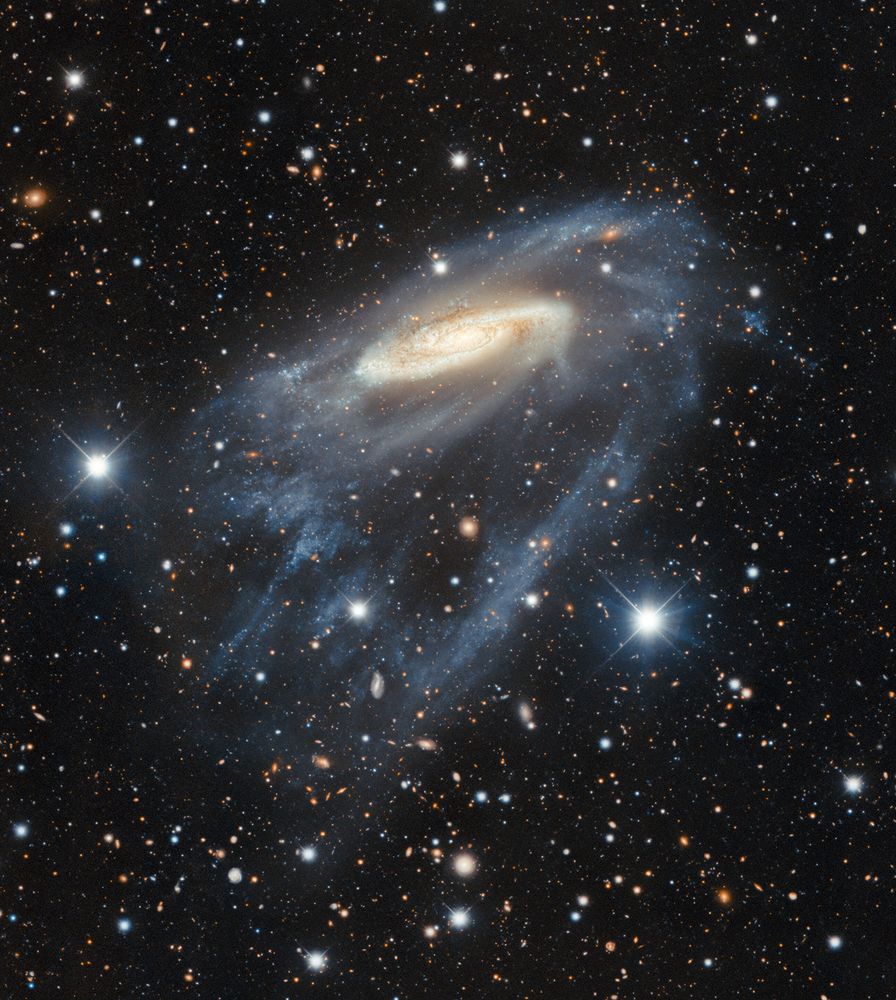
The yellow core of a disrupted spiral galaxy is surrounded by irregular, translucent spiral arms. The inner part of the galaxy is seen at an angle, so that it appears oval-shaped rather than circular. Dark brown dust lanes cross a yellow haze of older stars. The blue arms unfurl from the center, like paint flung out of a spinning canvas. They are dotted with blue star clusters. The arms dip down more at the bottom of the frame. The black background of space is filled with foreground stars and tiny background galaxies.
Dark Energy Camera image of Arp 289, also known as NGC 3981.
The galaxy's irregular arms is likely due to gravitational interactions with a neighboring galaxy.
Credit: Dark Energy Survey, DOE, FNAL, DECam, CTIO, NOIRLab, NSF, AURA, R. Colombari, M. Zamani
Source
22.11.2025 12:31 — 👍 67 🔁 11 💬 0 📌 1





























